Types of bass flute
There are essentially three main types of bass flute; the standard closed hole bass, the open hole bass and the Kingma System bass. All have curved headjoints and footjoints to low C are commonplace; a small minority of players have extended footjoints to take the range to low B but this is extremely rare. Most bass flutes are held horizontally, but recent innovations have resulted in some makers experimenting with upright (vertical) designs, with the instrument resting on a peg or spike, similar to a cello.
1. Standard (closed-hole) bass flute
This is the most common form of the instrument, and comes in a range of bore sizes and key configurations according to the designs of the individual makers. The instrument has closed holes, creating a number of limitations in terms of contemporary techniques. The lack of open holes restricts the number of multiphonic possibilities, in addition to the options for alternative fingerings, timbral trills and pitch flexibility. Also, different bore sizes, headjoint designs and key configurations mean that a technique that works well on one instrument may be more difficult or even impossible on another. B footjoints are rare on standard instruments, but offered as options by specialist makers such as Eva Kingma and Kotato and Fukushima.
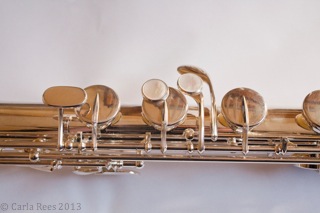
Left hand keywork of standard bass
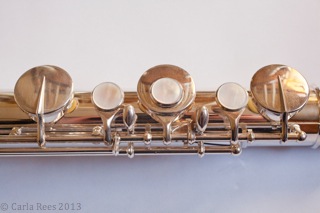
Right hand keywork of standard bass
2. Open-hole bass flutes
A very small number of makers (most notably Eva Kingma) offer open-hole options on bass flutes. These are still rare but increasing in popularity, and Kingma offers the option of three or five open holes. The extra venting created through the addition of open holes provides a greater range of possibilities of contemporary techniques, similar to the open hole C flute.
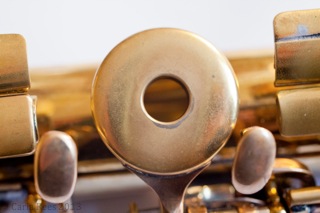
Open hole key
3. Kingma System bass flutes
The Kingma System, created by and named after Dutch flute maker Eva Kingma, has revolutionised the flute family for the 21st century. The Kingma System extends the capabilities of the open-hole flute, using a patented 'key on key' system (see photos below), which adds six extra keys to the open-hole design. This enables the player to control a small central hole in each key (similar to that created by the open hole of a standard open-holed flute) in addition to the larger hole covered by the entire key. The smaller holes create quartertone pitches, while the large outer holes create semitones.
On the bass flute, the size of the keys requires a slightly different layout of these extra keys than on the alto and C flute models, with some fingers operating two keys simultaneously, one which closes the outer rim of the key, and the other which closes the central hole.
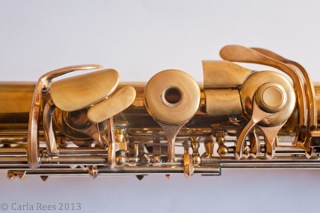
Left hand keywork of Kingma System bass
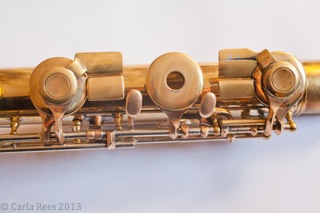
Right hand keywork of Kingma System bass
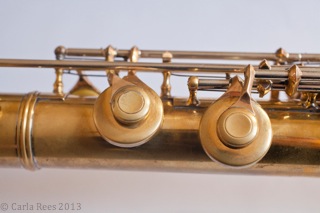
Key on key design of Kingma System
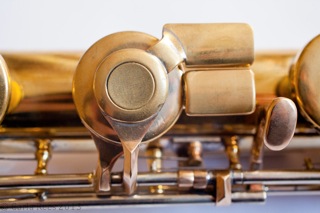
Kingma System F key
The new design gives enhanced flexibility to the bass flute player, creating new possibilities for composers and making much of the existing repertoire simpler to play. The bass flute is now capable of realising all of the extended techniques available to the open-hole C flute (although with modifications to suit the enlarged size of the instrument), in addition to a wider range of multiphonics, alternative fingerings, glissandi and other effects. Above all, the instrument is able to produce a reliable quartertone scale for the entire range from its written d'.
The upright design has numerous advantages, most notably from the point of view of ergonomics. The player no longer has to support the weight of the instrument, which is considerable owing to its size and the additional keywork, in his or her hands, allowing for freer fingerwork and considerably reduced physical tension. The player is able to adopt a more natural posture, with the instrument held in front of the body rather than to the side, with a resultant positve effect on breathing. The instrument may be played sitting or standing, and although some time is required to become accustomed to the new playing position, the headjoint remains in the same position against the bottom lip as with a horizontal bass flute. My own experience of this instrument is that the increased physical freedom enables longer playing times without the considerable physical discomfort which is often associated with playing an instrument of this size.
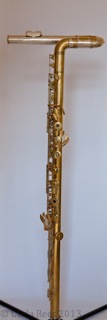

Comparison of Kingma System bass flute with a standard bass flute
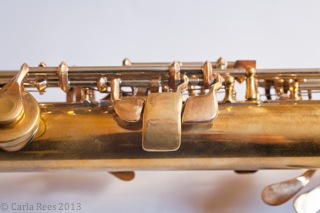
Thumb keys of Kingma System bass flute
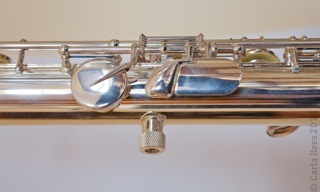
Thumb keys of standard bass flute

Standard C footjoint (top) and Kingma B footjoint
The information provided in this resource is primarily intended to assist composers with writing for the Kingma System bass flute, although some of the information may also be applied to closed- and open-hole instruments.